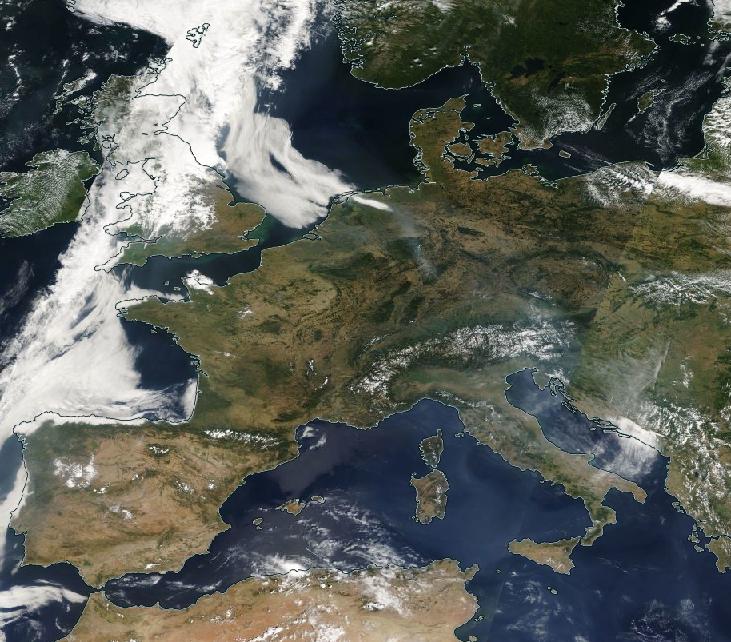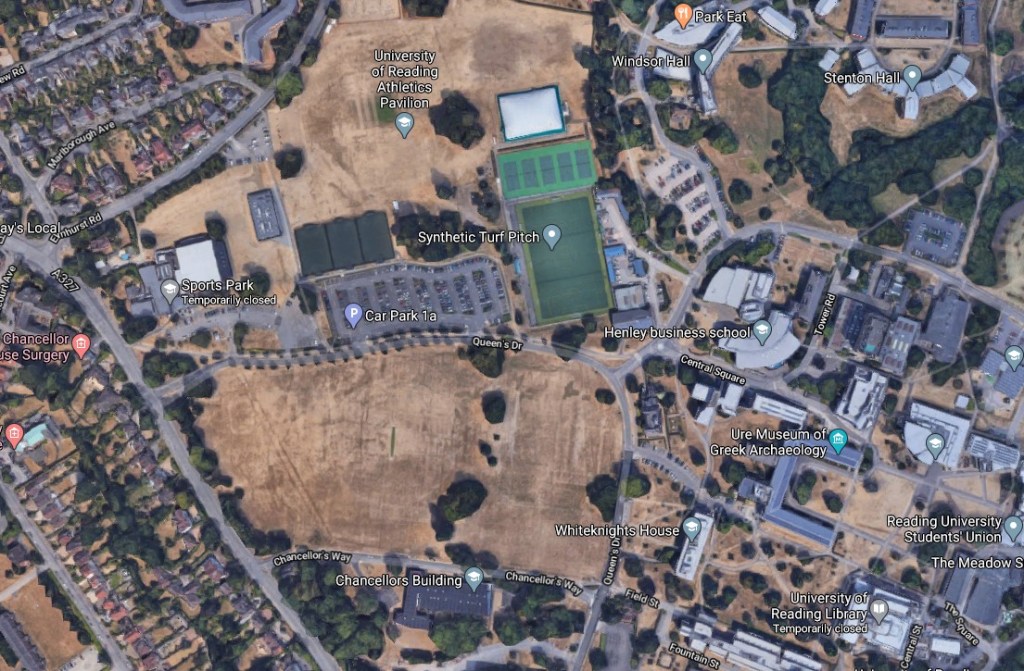Email: s.h.lee@pgr.reading.ac.uk
The phrase “British summer” tends to evoke images of disorganised family barbecues being interrupted by heavy rain, or the covers coming on at Wimbledon, or the saying “three fine days and a thunderstorm”. Yet in recent years, hot weather has become an increasingly regular occurrence. Let me take you on a brief tour of notably hot summers in the UK. I’ll largely draw on the Met Office HadUK-Grid dataset, shown in Figure 1.

HadUK-Grid begins in 1884, but thanks to the Central England Temperature dataset (which extends back to 1659), we do have records of earlier heatwaves. These include the hot summer of 1666, which set the scene for the Great Fire of London in September. The summers of 1781, 1826 and 1868 were also particularly hot. The first hot summer in the HadUK-Grid series is 1899, which was the warmest summer by average maxima in that series until 1976!
But our journey properly begins in 1911, when the temperature reached 36.7°C on August 9th. At the time, this was the highest reliably recorded temperature measured in the UK. It is hard to imagine how this summer must have felt at the time – not least in the cooler average climate, but also with the less developed infrastructure and clothing customs of the time. As with any heatwave, its impacts were large with increased death, drought, and agricultural impacts. The summer of 1911 was followed by the summer of 1912, which was the 2nd wettest on record for the UK. Such a turnaround must have been equally hard to believe and does highlight that extreme swings in the British weather are not, in themselves, new. In a series from 1884, the summer of 1911 is the 8th warmest in terms of the UK average maximum temperature (at the time, it would have been 2nd, with only 1899 warmer).
Stopping briefly in 1933 (which eclipsed 1911, but pales in comparison with the dustbowl conditions being experienced in the US at the time) and then again in August 1947 (which remains 2nd warmest for UK average maxima and the nation’s driest, and was in huge contrast to the tremendously snowy and cold February), our next destination is 1975.
1975 currently ranks as the 11th warmest for UK average maxima but is also the 19th driest. This, when combined with the dry winter that followed, set the scene for the infamous summer of 1976. Both these summers followed a spell of very cool summers, with no particularly remarkable summers in the 1960s, while the UK did not see a temperature above 28°C in 1974 (almost unthinkable nowadays). I won’t go into huge detail about the 1976 summer, but it is engrained in the minds of a generation thanks not only to its remarkable June heatwave (which has never been matched) but also the cool climate in which it occurred. It ranks as the 2nd driest summer for the UK and remains the warmest on record in terms of average maxima – though no individual month holds the number 1 spot.
Let us next whizz off to July 1983, which at the time had the warmest nationally averaged maxima for the month (it now ranks 3rd). Oddly enough, while the UK baked in heat, the temperature at Vostok, Antarctica dropped to -89.2°C on the 21st – the lowest surface-based temperature ever recorded. I am keeping the topic of this blog to hot summers, but I want to give 1985 a special mention – the most recent summer when the UK-average maxima were less than 17°C, a formerly frequent occurrence.
As we hot-foot it toward the end of the 20th century (pun intended), we arrive at 1990. Liverpool had just won the First Division (sound familiar?) and on August 3rd the temperature at Cheltenham, Gloucestershire reached 37.1°C – beating the record set in 1911 after 79 years. That night, the temperature fell to only 23.9°C in Brighton – the warmest night on record. However, the heatwave was rather brief but intense (3 consecutive days exceeded 35°C, the only other occurrences were in 1976). For a prolonged heatwave, we jump to August 1995. With a UK average maximum of 22.8°C, it remains the UK’s warmest August by that metric, and the 2nd driest. The summer ranks 2nd warmest by maxima. Soon after, the August of 1997 (4th warmest) added to growing evidence of a change to the British climate.
But it was in the August of 2003 when things really kicked off. In the earliest heatwave I remember, the temperature hit 38.5°C on the 10th at Faversham, Kent (satellite image in Figure 2) – the first time the UK had surpassed 37.8°C (100°F) and breaking the record from 1990 after only 23 years. 30°C was exceeded somewhere for 10 consecutive days. The summer of 2003 ranks nowadays as 6th warmest by average maxima; across Europe conditions were more extreme with a huge estimated death toll.

Only 3 years later, July 2006 set the record for the hottest month for the UK-average maxima (23.3°C), and set – at the time – a record for the highest-recorded July temperature (36.5°C at Wisley on the 19th). Ranking 4th warmest by average maxima, the summer was even more extreme across mainland Europe.
What followed from 2007 through 2012 was a spell of wet summers, but we shrug off all that Glastonbury mud to arrive at July 2013, which currently ranks as 4th warmest by average maxima and saw the longest spell of >28°C weather since 1997.
Skipping through in increasingly short steps, we arrive for a brief blast on July 1st, 2015 – when the July record from 2006 fell, with 36.7°C at Heathrow in an otherwise cool month. We hop over now to 2018…
The summer of 2018, memorable for England’s performance in the World Cup, saw very warm temperatures in June and July. By nationally averaged maxima, June 2018 ranks 2nd behind 1940, and July sits 2nd behind 2006. The summer ranks 3rd, but by mean temperature is the warmest. Though not reaching the dizzying highs of 2003 (“only” 35.3°C was reached on July 26th), the prolonged dry conditions which began in May across England led to parched grasses (Figure 3), wildfires, and low river levels. I may have also had a viral tweet.

With the present day in sight, our journey is not yet over. Stepping into 2019, an otherwise unremarkable summer was characterised with huge bursts of heat – setting records across Europe – which on July 25th saw the temperature reach 38.7°C at Cambridge Botanic Gardens. This eclipsed the 2003 record and became only the 2nd day – at the time – when 100°F or more had been reached in the UK.
But that is still not the end of the story! After a record-setting sunny spring followed by a mixed first half of summer, on July 31st 2020 the temperature at Heathrow hit 37.8°C – becoming the UK’s third warmest day on record and the third time 100°F had been recorded. The following Friday, 36.4°C was reached at Heathrow and Kew – the UK’s 9th warmest day on record, and highest temperature in August since 2003. Figure 4 shows the view at the University atmospheric observatory shortly after 34.8°C was reached, Reading’s 4th highest in August since records began in 1908.

Forecasts suggest a continuation of hot weather through the next week or so, with many records up for grabs. However, we should be mindful that heatwaves cause suffering and excess deaths, too. And, with the evidently increasing frequency with which these hot extremes are occurring (note how so many of the stops on my tour were clustered in the last 30 years), they are not good news, but another sign that our climate is changing.
Now that we have blasted through the 100°F barrier, our attention turns to 40°C. Research suggests this is already becoming much more likely thanks to climate change and will continue to do so. Reaching such extremes in the UK requires a unique combination of factors – but when these do come together, expect yet more records to fall.
Thanks to Stephen Burt for useful discussions.
Further Reading:
McCarthy, M., et al. 2019: Drivers of the UK summer heatwave of 2018. Weather, https://doi.org/10.1002/wea.3628.
Black, E., et al. 2006: Factors contributing to the summer 2003 European heatwave. Weather, https://doi.org/10.1256/wea.74.04
Burt, 2006: The August 2003 heatwave in the United Kingdom: Part 1 – Maximum temperatures and historical precedents. Weather, https://doi.org/10.1256/wea.10.04A
Burt and Eden, 2007: The August 2003 heatwave in the United Kingdom: Part 2 – The hottest sites. Weather, https://doi.org/10.1256/wea.10.04B
Brugge, 1991: The record-breaking heatwave of 1-4 August 1990 over England and Wales. Weather, https://doi.org/10.1002/j.1477-8696.1991.tb05667.x
5 thoughts on “A Journey through Hot British Summers”